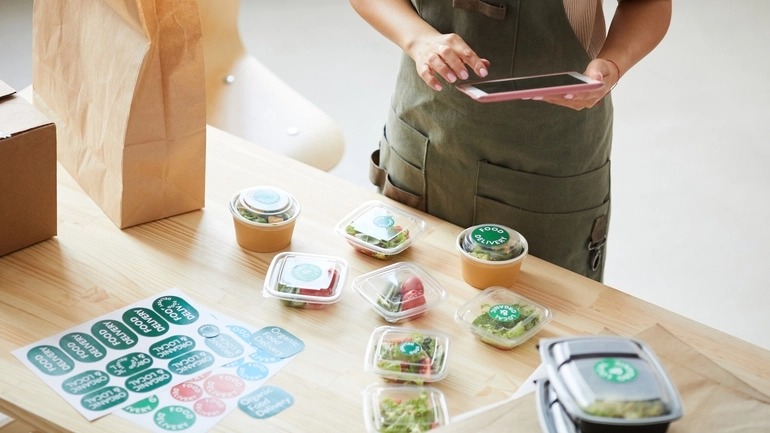Restaurant branding immediately evokes the feelings, flavors, and memories we associate with the eateries they represent.
For example, when you hear McDonald’s’ “I’m lovin’ it” jingle and see those golden arches, you may think of celebratory Happy Meals from your youth, or moments spent waiting in the drive-through, excitedly anticipating a Big Mac or McNuggets.
Whether it’s a specific font, a certain shade of red, or even a jingle, the right restaurant brand guidelines can instantly make us recall our favorite restaurant names and inspire cravings – that’s what makes branding so powerful.
Branding doesn’t just help international chains. Restaurants of all kinds and sizes can benefit from a strong identity. We’ve created this guide to branding for restaurants to help you transform your business into a brand that transcends the food on your menu.
This guide will cover:
- What restaurant branding is
- What is included in restaurant branding
- How to brand a restaurant in three steps
- Effective restaurant branding ideas and examples
What is Restaurant Branding?
Restaurant branding leverages multi-sensory elements to convey the intangible elements that make your business unique. Your restaurant’s logo, its interior design, the names you give menu items, the sounds pumping through your speakers, and even the scent that wafts in from your kitchen all inform your brand.
Your business is about more than just the dishes it serves. Branding a restaurant creates emotional connections between consumers and businesses, which ultimately helps increase sales.
What is Included in Restaurant Branding?
Restaurant branding includes several different elements, but it is primarily a collection of visual assets such as your logo, brand colors, menu design, and interior design, as well as communication assets such as your slogan, mission statement, and brand voice.
Branding a Brand Identity in 3 Steps
You don’t need to be a design or marketing expert to understand how to brand a restaurant successfully. Here, we break down the strategies behind branding for restaurants into three easy-to-follow steps.
1. Define your Restaurant Brand
Before you start sharing your brand with the world, you need to define and refine it for yourself. Identifying your mission statement, values, market, and ideal customers informs your brand positioning statement, and helps to set you apart from the competition. This will form the foundation of your restaurant brand guidelines to come.
Mission Statement and Values
Your restaurant’s mission statement and values help your business express its goals and purpose. They serve as your north star, guiding every other branding decision, so choose them carefully.
For example, if your mission statement communicates that your brand values customer service, you could align any restaurant slogans you create to include a promise of quality and satisfaction.
Your mission statement should explain why your restaurant exists. What is its purpose? Why did you decide to start your business?
- Fictitious example: “Les Bagliers is on a mission to bring the joys of Montréal-style bagels beyond Québec.”
- Starbucks’ mission: “To inspire and nurture the human spirit – one person, one cup, and one neighborhood at a time.”
Your values express what you stand for and believe in.
- Fictitious example: “Les Bagliers prides itself on using only authentic recipes and methods, and doesn’t take shortcuts.”
- Del Frisco’s Restaurant Group’s values: “Passionate team, remarkable hospitality, incredible cuisine, meticulous execution, [and] exceptional results.”
Target Market
Your target market is the ideal customer base you want to serve. Consider their geography, demographics, lifestyle, and behaviors for a holistic understanding of whom your restaurant’s branding needs to resonate with.
- Geography: Where are your customers located? Does this area have any unique considerations? Which areas would you like to expand into?
- Demographics: Who is your ideal customer? How old are they? How much money do they make? What do they do for a living?
- Lifestyle: What do your customers value? What are they interested in?
- Behaviors: What are your customers’ pain points? What are their spending habits like?
Need help conducting market research for your restaurant? Work with a market research firm or restaurant consulting firm to unlock expert insights.
Brand Positioning
After you’ve written your mission statement, identified your values, and defined your target market, you’re ready to create a brand positioning statement. This messaging concisely expresses the value you bring to your customers and explains what makes you different from the competition.
Your statement should answer the following questions:
- Why are you in business? (mission statement)
- Who does your restaurant serve? (target market)
- What’s your brand promise? (values)
- How does your restaurant distinguish itself from other restaurants?
You’ve already figured out the first three parts of your positioning statement, so let’s work on identifying what makes your restaurant different.
Consider how the food your restaurant offers sets it apart. What kind of cuisine do you serve? How is your spin on these dishes different from how other restaurants serve similar foods? For example, are you focused on creating the most authentic cuisine possible, or are you modifying recipes to appeal to a wide array of customers?
Price point is another differentiator. The Journal of Foodservice Business Research found that as a restaurant’s “price[s] increase, customers interpret this as an improvement in product quality. The higher the price, the higher the perceived quality and customer expectations of value are likely to be.” Think of pricing as not only a business decision, but also as a tool for branding a restaurant.
With all of these elements in mind, this is the brand positioning statement the bagel shop from our fictitious example might come up with:
“We took 100 years of tradition and perfected the Montréal-style bagel. Now we’re sharing a piece of Montréal with gourmands around the world. Say ‘bonjour’ to your new favorite bagel.”
2. Develop Your Restaurant Brand Identity
Now that you’ve defined the foundation for your brand, the next step is to create style guides for your written and visual identities.
Writing Style Guide
In your restaurant brand guidelines, your writing style guide defines your brand’s voice, tone, and use of language.
- Voice is your brand’s perspective. Your restaurant’s mission statement and values inform its voice.
- Tone is how that voice sounds. It encompasses the attitude and formality (or informality) you want to convey through your restaurant’s written (e.g., social media posts) and verbal (e.g., how staff greet customers) communications.
- Style comprises both voice and tone. It’s the language you use to express your brand. It’s the words you choose. For example, “dollar menu” and “value meal” mean similar things at face value, but each phrase carries its own connotations that affects its overall meaning.
Use your style guide to inform your staff script, menu copy, website copy, promotions, emails, and social media for consistency.
Visual Style Guide
Your visual style guide sets the standards for how you express your brand through imagery. Consider the overall look of the brand, color palette, and typography you want to use. Keep your writing style guide in mind while developing your visual style guide to ensure coherent branding for your restaurant.
- Will your visual brand be modern or retro, kitschy or elegant? Use your mission and values to conceive the overall vibe of your restaurant’s brand design elements. Every brand asset (i.e., logo, menu, interior design, etc.) should relate back to this vision.
- Colors can make customers feel a certain way, so choose your palette wisely. Warm colors like red, orange, and yellow increase appetite (think McDonald’s), yellow and orange convey joy, and green conveys health (we’re looking at you, Subway). Stay away from blue and purple, as they’re seldom found naturally in foods and can therefore decrease appetite.
- Typography also represents your style. For example, a serif font gives off a traditional look, while a sans serif font leans modern.
Check out this resource from Canva if you need more help creating your visual style guide.
3. Design Your Brand Assets

Use your brand positioning statement and style guides as blueprints for creating all kinds of brand assets.
Brand Logo
Your restaurant’s logo is its most important brand asset, so we recommend working with a professional to create one. It should be simple, memorable, and tell customers a lot about your restaurant from one glance.
Share your style guides, mission, values, and brand positioning statement with your graphic designer, and they’ll come back to you with something that resonates with customers and matches your vision.
Website
A website needs to inform customers and convey the look and feel of your restaurant. Incorporate images of your restaurant’s interior and its cuisine on your website – and other assets – for a cohesive experience.
Pay special attention to your about page, as it can help your customers connect with your brand. This is a good place to share your values and mission statement with the world.
Social Media
Your restaurant’s social media presence may seem more casual and spontaneous than its other assets, but as an extension of the brand, it should be crafted with intention. Follow your style guides to ensure consistency.
Create templates for social media graphics featuring your logo, colors, and fonts, to save time while strengthening your visual restaurant brand identity.
Menu
Design a menu that adheres to your style guides and maximizes profits.
Also, consider how your menu affects your brand positioning. For example, menus with fewer items are typically associated with upscale concepts, while endless options are often associated with casual restaurants.
Restaurant Design
Your restaurant’s interior design, signage, plateware, takeout packaging, and even the music you play, all contribute to its branding.
According to HUI Research, restaurants see a 9.1% increase in sales when they play music that matches their brand instead of a random playlist.
The ambiance you set says something about your business and impacts revenue by strengthening your identity, so select restaurant brand design elements wisely.
Restaurant Branding Ideas and Examples
See the power of restaurant branding in action with these real-world restaurant branding examples.
Milk Bar
Milk Bar’s brand is all about taking classic desserts and turning them on their head. Think soft serve ice cream infused with cereal milk, and cookies peppered with crispy cornflakes.
The dessert brand’s logo is instantly recognizable. Its bright pink color and font make it look like a neon sign alerting you to irresistible treats.
Olive Garden
Olive Garden is one of the best restaurant branding examples because everything about Olive Garden’s branding works together to fulfill its brand promise: “when you’re here, you’re family.” Regardless of your background, a meal at Olive Garden makes you feel like you’re sharing a meal with your Italian grandma, cousins, siblings, aunts, and uncles.
The chain’s interior design makes you think you’ve taken a trip to Tuscany, with warm Mediterranean hues and string lights hanging from trellises.
The family style restaurant appeals to parents by upselling breadsticks for Santa and placing gaming tablets on tables for kids.
Even the restaurant’s typography is welcoming. Its As and Rs have extended legs that look like they’re hugging the characters next to them. This font brings letters together, just like how the restaurant brings people together around food.
Sweetgreen
Sweetgreen’s mission is all about inspiring healthier communities. The growing chain disrupted the quick service sector by serving build-you-own salads with locally sourced ingredients, thereby proving that fast food can be healthy. In fact, every location has a chalkboard that lists where all of its ingredients come from.
Now Sweetgreen is on a mission to show that they’re more than just a salad chain – they’re a lifestyle brand. The restaurant used to produce a music festival, and now partners with artists to curate playlists on Spotify. The brand is reaching younger, tech-savvy customers by having an active TikTok presence and encouraging customers to use their app.
And, by promising carbon neutrality by 2027, Sweetgreen is demonstrating that the food we eat isn’t the only thing that builds healthier communities.
Strategically branding a restaurant will elevate your business beyond the food it serves. Branding transforms your restaurant into a holistic presence that stands for something and makes customers feel a certain way. Nail down your mission, values, and brand positioning, create brand style guides, then develop assets that resonate with customers and keep them coming back for more.
Free social media templates for your restaurant
Sign up for our free weekly TouchBistro Newsletter







